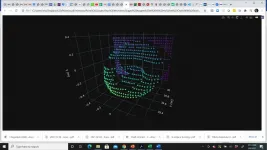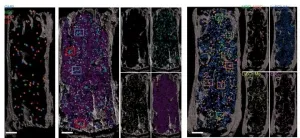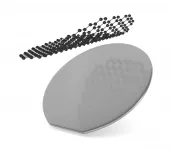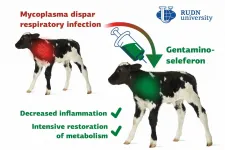Silicon chip provides low cost solution to help machines see the world clearly
2021-02-10
(Press-News.org) Researchers in Southampton and San Francisco have developed the first compact 3D LiDAR imaging system that can match and exceed the performance and accuracy of most advanced, mechanical systems currently used.
3D LiDAR can provide accurate imaging and mapping for many applications; it is the "eyes" for autonomous cars and is used in facial recognition software and by autonomous robots and drones. Accurate imaging is essential for machines to map and interact with the physical world but the size and costs of the technology currently needed has limited LIDAR's use in commercial applications.
Now a team of researchers from Pointcloud Inc in San Francisco and the University of Southampton's Optoelectronic Research Centre (ORC) have developed a new, integrated system, which uses silicon photonic components and CMOS electronic circuits in the same microchip. The prototype they have developed would be a low-cost solution and could pave the way to large volume production of low-cost, compact and high-performance 3D imaging cameras for use in robotics, autonomous navigation systems, mapping of building sites to increase safety and in healthcare.
Graham Reed, Professor of Silicon Photonics within the ORC said, "LIDAR has been promising a lot but has not always delivered on its potential in recent years because, although experts have recognised that integrated versions can scale down costs, the necessary performance has not been there. Until now.
"The silicon photonics system we have developed provides much higher accuracy at distance compared to other chip-based LIDAR systems to date, and most mechanical versions, showing that the much sought-after integrated system for LIDAR is viable."
Remus Nicolaescu, CEO of Pointcloud Inc added, "The combination of high performance and low cost manufacturing, will accelerate existing applications in autonomy and augmented reality, as well as open new directions, such as industrial and consumer digital twin applications requiring high depth accuracy, or preventive healthcare through remote behavioural and vital signs monitoring requiring high velocity accuracy.
"The collaboration with the world class team at the ORC has been instrumental, and greatly accelerated the technology development."
The latest tests of the prototype, published in the journal Nature, show that it has an accuracy of 3.1 millimetres at a distance of 75 metres.
Amongst the problems faced by previous integrated systems are the difficulties in providing a dense array of pixels that can be easily addressed; this has restricted them to fewer than 20 pixels whereas this new system is the first large-scale 2D coherent detector array consisting of 512 pixels. The research teams are now working to extend the pixels arrays and the beam steering technology to make the system even better suited to real-world applications and further improve performance.
INFORMATION:
[Attachments] See images for this press release:

ELSE PRESS RELEASES FROM THIS DATE:
2021-02-10
CINCINNATI--Imagine a day when clinicians treating people with blood diseases such as leukemia or multiple myeloma can send in requests for laboratories to custom-produce specific types of blood cells to replace those affected by the disease.
That day became one step closer to reality with a new study led by experts at Cincinnati Children's that provides powerful new insights into how bone marrow tissue works.
The study, published Feb. 10, 2021 in Nature, was led by senior author Daniel Lucas, PhD, and first authors Jizhou Zhang, MD, and Qingqing Wu, PhD, from the Division of Experimental Hematology and Cancer Biology. Co-authors include a team of scientists from Cincinnati Children's and the University of Cincinnati, plus collaborators in Colorado, Texas and Michigan.
The ...
2021-02-10
Imaging planets orbiting around nearby stars, which could potentially harbour life, has become a possibility thanks to the progress made in observational methods by an international team of astronomers. First candidate: Alpha Centauri, a system similar to ours, "only" 4.3 light years away. This study is the subject of a publication in the journal Nature Communications.
Efforts to obtain direct images of exoplanets - planets outside our solar system - have so far been hampered by technological limitations, which have led to a bias towards detecting planets much larger than Jupiter, around very young stars and far from the habitable zone, the area in which a planet may have liquid water on its surface, and thus ...
2021-02-10
Researchers from the University of Seville's Nursing Department, with the collaboration of professionals from the ICU at Virgen Macarena University Hospital in Seville, have analysed the key factors in caring for critical COVID-19 patients during the first wave of the pandemic. Their study concludes that nursing care was impacted by fear and isolation, which made it difficult to maintain the human experience of health care.
The break down in the humanising trend of ICU care during this period was mainly the result of the isolation of COVID-19 patients. This, along with the personal protection equipment worn by staff to prevent becoming infected ...
2021-02-10
10,000 km2 of ice disappeared in a blink of an eye from an ice sheet in the Storfjorden Through offshore Svalbard, a new study shows. This dramatic break off was preceded by quite a rapid melt of 2.5 kilometres of ice a year. This parallels the current melt rates in Antarctica and Greenland and worries the scientists behind the study.
"Our measurements of the ice retreat in Storfjorden Through show that the prevailing conditions to the great break off, match what we see in Antarctica and Greenland today. It is uncanny. There are new studies published almost weekly, that show that the retreat of current ice sheets is two to four km a year and that it's speeding up." Says CAGE-professor and first author Tine Lander Rasmussen.
Climatically unstable period
The last deglaciation, ...
2021-02-10
Two-dimensional (2D) materials have a huge potential for providing devices with much smaller size and extended functionalities with respect to what can be achieved with today's silicon technologies. But to exploit this potential we must be able to integrate 2D materials into semiconductor manufacturing lines - a notoriously difficult step. A team of Graphene Flagship researchers in Sweden and Germany now reports a new method to make this work.
The technique, just published in Nature Communications by researchers from Graphene Flagship partners RWTH Aachen University, Universität der Bundeswehr ...
2021-02-10
New research from Trinity College Dublin suggests that older adults can be more focused, less impeded by anxiety and less mentally restless than younger adults. The team at the Trinity College Institute of Neuroscience (TCIN) (today, Wednesday, 10th February, 2021) show that older adults appear to mitigate the negative aspects of cognitive decline by increasing motivation and adopting more efficient strategies to suspend the wandering mind when focus is required.
The study, published in the journal Psychology and Aging (American Psychological Association) is the first to adjudicate between competing theories of age-related ...
2021-02-10
In recent years, three meta-analyses of clinical studies have come to the conclusion that vitamin D supplementation was associated with a reduction in the mortality rate from cancer of around 13 percent. Scientists at the German Cancer Research Center (DKFZ) have now transferred these results to the situation in Germany and calculated: If all Germans over the age of 50 were to take vitamin D supplements, up to 30,000 cancer deaths per year could possibly be avoided and more than 300,000 years of life could be gained - in addition, health care costs could be saved.
For several years now, scientists have been investigating the influence of an adequate supply of vitamin D on the ...
2021-02-10
Overfishing, hunting and intensive agriculture and forestry can sometimes contribute to plants and animals becoming endangered. New research from Lund University in Sweden and University of Toronto can now show why this leads to entire populations becoming smaller in size, as well as reproducing earlier. The study is published in the journal PNAS.
Researchers from Lund and Toronto are behind the study conducted on five different species of damselflies. They have studied how different environmental factors affect when and at what size the damselflies begin to reproduce. In the study, the researchers also shed light on how overfishing off the coast ...
2021-02-10
COLUMBUS, Ohio - The death of a vampire bat 19 days after giving birth presented scientists studying the animals in 2019 with an unexpected chance to observe a rare event: a female bat's adoption of an unrelated baby.
The researchers had captured common vampire bats in Panama as part of ongoing studies of the formation of cooperative relationships among strangers. The team used infrared surveillance cameras to observe six hours of vampire bat activity spaced over the span of each day.
Two unrelated and unfamiliar female bats were observed forming a social bond based on mutual grooming and food sharing that increased over time. The researchers had named them BD and Lilith.
Lilith ...
2021-02-10
Respiratory tract diseases in young animals of the cattle are a big issue for world agriculture and food safety because a bacterium that causes them is resistant to most antibiotics. A team of veterinarians from RUDN University developed and tested a complex preparation called gentaminoseleferon that could help treat respiratory infection in calves. The results of the study were published in the Veterinary World journal.
Bacteria of the genus Mycoplasma cause many infectious diseases in animals, including atypical pneumonia, other respiratory tract conditions, reproductive pathologies, arthritis, keratoconjunctivitis, mastitis, and so on. The genus includes about 200 species of bacteria, and all of them ...
LAST 30 PRESS RELEASES:
[Press-News.org] Silicon chip provides low cost solution to help machines see the world clearly




